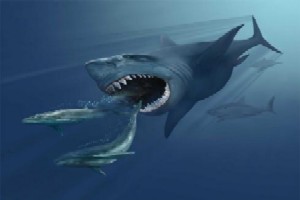 Artist's depiction of a megalodon chasing two blue whales (image credit: Karen Carr, the Virginia Museum of Natural History)
Artist's depiction of a megalodon chasing two blue whales (image credit: Karen Carr, the Virginia Museum of Natural History)
Often I am drawn back to one place at the California Academy of Sciences, staring down at the dancing forms in the Lagoon's shallow water. Rays and sharks glide easily just above the tropical sand. Eventually, I see the lagoon’s shyer inhabitant, the guitarfish, whose body markings and shape resemble an upside down guitar. Sharks, ray, and guitarfish all belong to the subclass Elasmobranchii within the cartilaginous fish class Chondrichthyes. The Elasmobranchii also includes the infamous megalodon, thought to be the largest carnivorous fish ever to have existed. The megalodon was famed to reach lengths between 45 and 90 feet, dwarfing even today's most fearsome Great Whites.
What I find most interesting about this subclass is the body make-up these creatures share. They do not have a bony skeleton like humans; their skeleton is made up of cartilage—a dense connective tissue that is tough yet elastic. Their grace, speed, and great success as predators come from the fluidity of their movement.
This also makes it difficult for Ichthyologists to agree on taxonomy within this class as fossilized remains of cartilaginous fish are often poor. The oldest fossil on record of a megalodon, 18 million years old, is the only bone in the skeleton: a tooth. From the tooth, several researchers have tried to reconstruct the jaw and piece together what the body would look like. The tooth also suggests what this massive prehistoric shark preyed upon: There are bite marks on whales, dolphins, porpoises and sea turtles.
As the sharks, rays, and guitarfish pass by in the lagoon, I imagine the shadow of their giant cousin, the megalodon.
37.769700 -122.466000
